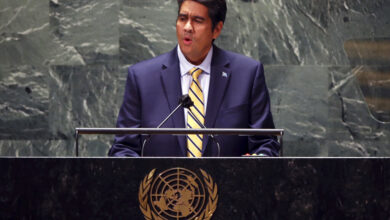New drug ‘precursors,’ political challenges complicate fight against traffickers

FORUM Staff
The COVID-19 pandemic, a military coup in Burma and new “precursor chemicals” have all contributed to a recent boom in the production of illegal synthetic drugs in the Indo-Pacific region.
Precursors are legally produced chemicals such as ephedrine and pseudoephedrine — cold-remedy ingredients — that criminal syndicates use to make illicit drugs such as methamphetamine, commonly known as meth.
Authorities in the Indo-Pacific seized a record of more than 150 metric tons of meth in 2020, up 19% from 2019, according to a June 10, 2021, report by the United Nations Office on Drugs and Crime (UNODC). There was a short disruption at the height of COVID-19 restrictions, but trafficking has returned at an even higher level, according to the report, which came ahead of the U.N.’s International Day Against Drug Abuse and Illicit Trafficking on June 26.
“While the pandemic has caused the global economy to slow down, criminal syndicates that dominate the region have quickly adapted and capitalized,” Jeremy Douglas, UNODC’s regional representative for Southeast Asia and the Pacific, said in a statement.
Those adaptations include the use of “pre-precursors” — chemicals that until recently weren’t identified as ingredients in the production of meth, which has become the most popular illegal drug in the Golden Triangle, an area that includes parts of Burma, Laos and Thailand.
Authorities say the supply chain for synthetic drugs originates in poorly regulated factories in China that produce precursor chemicals. A 2018 report by John Langdale of Australia’s Macquarie University singled out manufacturers in Guangdong province as a primary source, according to Canada’s Global News. From there, the chemicals were moved to drug labs in the Golden Triangle, with Burma as a leader in meth production.
The region’s drug traffickers, which range from warlords to militia groups to Chinese gangs known as triads, sought ways to boost trade during COVID-19 constraints. The UNODC report, for example, noted the emergence of large-scale meth production in Cambodia. “It looks like organized crime [syndicates] are hedging a bit and shifting some production so not everything is as concentrated,” Douglas told Reuters.
Meth production has gone into overdrive since the February 1, 2021, coup in Burma disrupted the balance of power in the Golden Triangle, Voice of America (VOA) News reported. People who use meth long term may exhibit symptoms that can include significant anxiety, confusion, insomnia, mood disturbances and violent behavior in addition to a number of psychotic features, including paranoia, visual and auditory hallucinations and delusions, according to the National Institutes of Health.
“Fighting in Myanmar [Burma] near the drug production sites is forcing out the products at a higher volume than usual,” Police Maj. Gen. Pornchai Charoenwong, deputy commissioner of Thailand’s Narcotics Suppression Bureau, told VOA. The drugs flow through Thailand to elsewhere in the Indo-Pacific. (Pictured: Royal Thai Armed Forces members patrol for drug trafficking along the Mekong River on the border with Laos in May 2019.)
Experts say that political upheaval such as the coup in Burma makes for a better operating environment for organized crime and increases drug-enforcement challenges. In February 2020, intelligence specialists from across the region, as well as Australia, Canada and the United States, gathered in Burma to exchange information and strategies to disrupt chemical trafficking.
One recent disruption came in May 2021 when the Australian Border Force seized 316 kilograms of “ice” — a highly addictive form of crystal meth with a street value of nearly U.S. $80 million — packed inside home products originating from a Thai port.
“Organized crime groups are innovative and continuously looking for ways to evade law enforcement detection for trafficking in precursor chemicals,” Inshik Sim, an UNODC drug program analyst, said in a statement. “Intelligence sharing is key … as it helps us better anticipate their plans and build strategic and operational responses.”
IMAGE CREDIT: AFP/GETTY IMAGES




